
Questions that fall under the umbrella of the Command of Evidence SAT subscore appear on both the Reading and Writing sections of the SAT. This article will focus exclusively on Command of Evidence questions in the Writing section, including examples from practice tests, answer explanations, and test-taking tips that are specific to these types of questions. Head over to this article instead if you're looking for a detailed discussion of Command of Evidence questions in the Reading section.
What Are Command of Evidence Questions? What Do They Test?
Command of Evidence is one of the new subscores on the SAT. There are 18 total Command of Evidence questions on the test (Reading and Writing together), eight of which will appear on the Writing section. Your raw score out of 18 will be translated into a final subscore out of 15.
Command of Evidence questions on the Writing section ask you to improve the ways passages develop information and ideas. You might choose an answer that sharpens an argumentative claim or adds a relevant supporting detail. The three types of Command of Evidence questions that exist in the Writing section are the following (names of categories were provided by me, not the College Board):
- Type 1: Setting the Stage - Choose the right piece of evidence to include in the passage to set up the information the author presents later.
- Type 2: Logical Additions - Decide whether the author should add a given sentence to the passage strengthen the argument (and why or why not) or choose the best sentence to add out of four possibilities.
- Type 3: Data Descriptions - Choose the best way to phrase the passage so that it accurately reflects the data provided.
In the next section, I’ll take you through example questions from each of these categories so you can see exactly how to answer them on the test.
Examples of Command of Evidence Questions on Writing
In this section, I'll provide real examples and answer explanations for all three categories of Command of Evidence questions.
Type 1: Setting the Stage
Here’s an example of the first type of question. You’re asked to choose the phrase that most effectively introduces information in the passage:

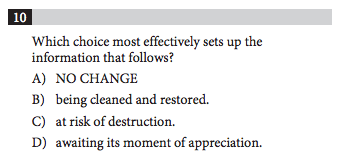
We have to decide whether the information flows well with the current phrasing or if “leading the way” should be replaced with one of the other three phrases to make things clearer. Choice B, “being cleaned and restored,” doesn’t quite fit because it relates to the information before that sentence, not the information that follows in the rest of the paragraph. It’s also superfluous because the author already stated that artists have been cleaning and restoring the murals. It can be inferred that “America Tropical” is included in this.
Choice C, “at risk of destruction,” is also incorrect because the rest of the paragraph mentions nothing about the mural being at risk of destruction. It’s just talking about the mural's new status as a tourist attraction. This is an irrelevant answer based on the evidence.
Choice D, “awaiting its moment of appreciation,” almost fits, but it’s still wrong. The mural isn’t AWAITING its moment of appreciation based on the last two sentences. It’s already being appreciated as a major tourist attraction.
Choice A, NO CHANGE, is the only answer that makes sense. The paragraph goes on to support the claim that the mural is “leading the way” by discussing its status as the first restored mural to become a prominent tourist destination and inspiration for cultural preservation.
Final Answer: A
 Another dope painting by Siqueiros (El Museo Nacional de Arte, used under CC by 2.0)
Another dope painting by Siqueiros (El Museo Nacional de Arte, used under CC by 2.0)
Type 2: Logical Additions
For this question type, you have to decide whether the author should include a sentence in the passage to reinforce his or her point OR decide which sentence out would make the most sense in the passage. I’ll give two question examples in this case because there are two different formats that you’ll see for this type of question. Here’s the first one (using the same part of the passage that we looked at in the last subsection):

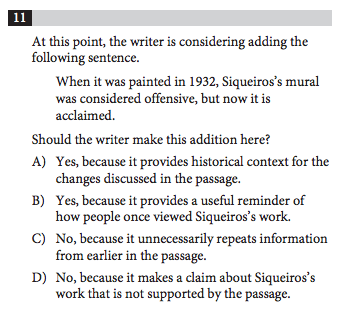 This question requires a little more context to find the right answer. First, read the passage with the suggested sentence inserted to get a sense of whether or not it should be included (I’ll wait). When you add the sentence, it feels like an inappropriate interruption that diverts attention from the main focus of the paragraph. It seems repetitive given that we already know the mural is considered a "powerful work." This narrows our options down to the two “no” answers, C and D.
This question requires a little more context to find the right answer. First, read the passage with the suggested sentence inserted to get a sense of whether or not it should be included (I’ll wait). When you add the sentence, it feels like an inappropriate interruption that diverts attention from the main focus of the paragraph. It seems repetitive given that we already know the mural is considered a "powerful work." This narrows our options down to the two “no” answers, C and D.
Is the information in the sentence already given earlier in the passage? Looking back, you can see that it was (this question comes from new SAT sample practice test four if you want to read the whole passage), so C is a possibility. What about D? Well, if the information was in the passage at one point, then the claim IS supported by the passage, so D has to be wrong.
Final Answer: C
Here’s another example of the same type of question formatted slightly differently:
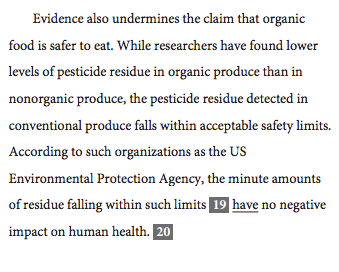
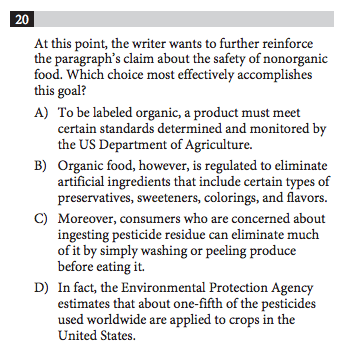
This time, we have to pick the best sentence out of four choices to insert into the paragraph. As it says in the question, we're looking for the sentence that best supports the author’s claim that there’s nothing wrong with nonorganic food.
Choice A has nothing to do with the author’s point, and, in fact, could serve as part of a counterargument (organic foods are more tightly regulated, so they’re safer for consumers!). We can rule out this one.
Choice B could also be a part of a counterargument - organic food is regulated to eliminate artificial ingredients! That's not helping the author’s case. Get rid of choice B too.
Choice C makes sense because it explains how the already small risks associated with ingesting pesticides can easily be eliminated just by washing or peeling nonorganic fruits and vegetables before eating them. This takes the author’s argument further and reinforces the main point of the paragraph.
Choice D is incorrect because it’s talking about the widespread use of pesticides, and the author is looking to deemphasize the impact of pesticide use. This answer can be eliminated, and we’re left with Choice C!
Final Answer: C
 Organic food successfully tapped into the flourishing market of suburbanites trying to one-up each other based on ultimately meaningless lifestyle choices.
Organic food successfully tapped into the flourishing market of suburbanites trying to one-up each other based on ultimately meaningless lifestyle choices.
Type 3: Data Descriptions
The final type of evidence question on the Writing section will ask you to look at data and make sure it lines up with the information in the passage. Here’s an example:
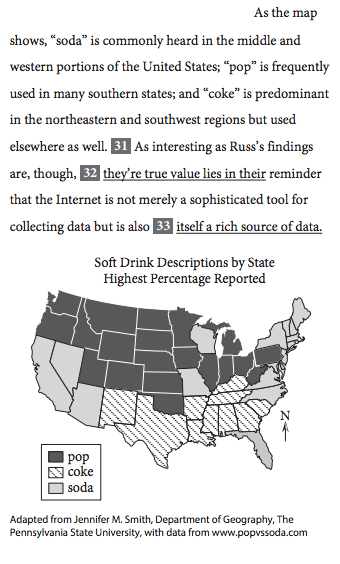
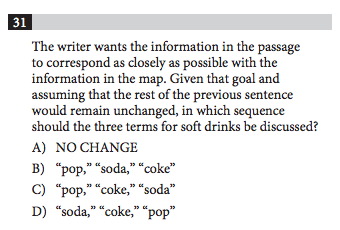
This question is simple if you read carefully, but it’s easy to get confused if you’re rushing. I actually read the passage incorrectly at first and thought the answer key had made a mistake! This question is careless mistake central.
Let’s look at the choices. In the original version of the passage, the descriptions of where each term is used do not correspond to the information on the map. The passage says that “soda” is the term most commonly used in the middle and western regions of the US while the map shows that “pop” is most common in these regions. The first term in the passage should be “pop” if all the other information is kept the same, so the answer is either B or C. The original passage goes on to say that “pop” is most common in southern states, which we know to be false. According to the map, it’s actually “coke.” The only answer that starts with “pop” and “coke” is choice C, so that’s the one we want!
Final Answer: C
 What do you call this stuff? If you answered "fizz juice," you'll never belong anywhere.
What do you call this stuff? If you answered "fizz juice," you'll never belong anywhere.
Tips for Answering Command of Evidence Questions on SAT Writing
Here are a few key Command of Evidence tips for when you come across these types of questions in the Writing section.
Tip #1: Plug in the Answer
If you’re given several different options for the appropriate phrase to insert, start reading one or two sentences before the question number shows up in the paragraph. Read through that part of the paragraph in its modified form, and then continue reading for a sentence or two afterward to see if it really makes sense in the flow of the passage (and based on the facts presented in the paragraph).
Command of evidence questions never take place in a vacuum, so it’s critical to read the surrounding text to make sure you have the right answer. Plugging in the potential answer and reading it through carefully is the best way to assess the viability of your choice.
Tip #2: Find Direct Support
The whole point of these questions is to test your ability to pick out answers that make the most sense based on the information in the passage. For every choice you make, you should be able to find part of the passage (or figure) that directly supports your answer. This is a good way to double-check that you didn’t make any unfounded assumptions (or reading mistakes) to arrive at your answer.
Tip #3: Read Carefully
The Writing section requires strict attention to detail, so try not to rush, and double-check your answers by reading them over again in the context of the passage. Pay attention to the tone and flow of the passage as a whole. There are a few questions where you’ll need to refer to evidence earlier in the passage to confirm your answers, like the question we did in the Logical Additions category. The sentence didn’t make sense because it repeated information that was already stated earlier in the passage.
Working methodically on these questions will prevent you from missing out on details or switching parts of the question around by accident. If you come across a data interpretation question, you should be completely sure of what the graph or chart is telling you before answering the question. Some of the SAT's data representations are more nuanced than you might expect.
 You must become one with the data. It's the only way.
You must become one with the data. It's the only way.
Conclusion
Command of Evidence is a subscore category on the SAT that spans across the Reading and Writing sections. Command of Evidence questions show up in the Writing section of the SAT in several different forms. The three varieties I've identified are:
- Setting the Stage (questions that ask you to choose the best phrase to insert to make information flow logically)
- Logical Additions (questions where you have to decide whether it makes sense to add something to the passage or not)
- Data Descriptions (questions that refer to charts or graphs and ask you to ensure that the information in the passage matches up with the data provided)
A few tips for answering these types of questions are:
- Tip #1: Plug in the Answer
- Tip #2: Find Direct Support
- Tip #3: Read the Passage Carefully
For Command of Evidence questions, finding the right answer is all about attention to detail and strong reading comprehension skills. Be sure to practice reading passages and paying attention to context so you can make the correct choices based on the evidence at hand.
What's Next?
If you're looking for more ways to improve your performance, check out our list of five key strategies that will help you excel on the Writing section.
You can also use this article to review the most important grammar rules for the SAT Writing section.
Speaking of writing, are you taking the SAT with the essay section? Learn more about how to get an awesome essay score.
Want to improve your SAT score by 160 points?
Check out our best-in-class online SAT prep program. We guarantee your money back if you don't improve your SAT score by 160 points or more.
Our program is entirely online, and it customizes what you study to your strengths and weaknesses. If you liked this Writing and grammar lesson, you'll love our program. Along with more detailed lessons, you'll get thousands of practice problems organized by individual skills so you learn most effectively. We'll also give you a step-by-step program to follow so you'll never be confused about what to study next.
Check out our 5-day free trial:
Have friends who also need help with test prep? Share this article!

Samantha is a blog content writer for PrepScholar. Her goal is to help students adopt a less stressful view of standardized testing and other academic challenges through her articles. Samantha is also passionate about art and graduated with honors from Dartmouth College as a Studio Art major in 2014. In high school, she earned a 2400 on the SAT, 5's on all seven of her AP tests, and was named a National Merit Scholar.


































 Holly R.
Holly R.